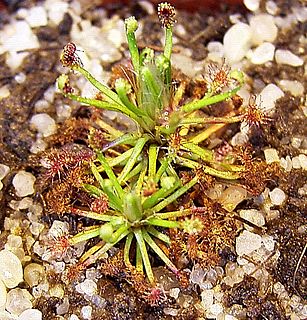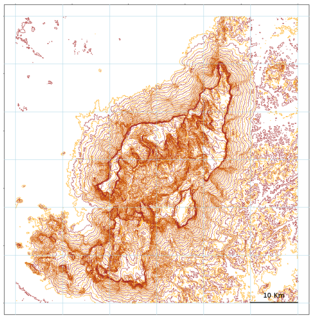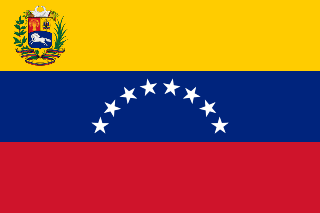
Tibouchina Aubl. is a Neotropical flowering plant genus in Melastomataceae Juss. that contains approximately 240 species. Species of this genus are herbs, shrubs or trees and typically have purple flowers. They are native to Mexico, the Caribbean, and South America where they are found as far south as northern Argentina. Members of this genus are known as glory bushes, glory trees or princess flowers. The name Tibouchina is adapted from a Guianan indigenous name for a member of this genus [2]. A recent systematic study has shown that this genus is paraphyletic.

Abolboda is a genus of flowering plants, traditionally and nowadays assigned to family Xyridaceae. It is native to South America and to the island of Trinidad, generally on marshy savanna.
- Abolboda abbreviataMalme - Pará in Brazil
- Abolboda acaulisMaguire - Venezuela, Guyana
- Abolboda acicularisIdrobo & L.B.Sm. - Venezuela, Colombia
- Abolboda americana(Aubl.) Lanj. - Trinidad & Tobago, Colombia, Venezuela, the Guianas, northern Brazil
- Abolboda bellaMaguire - Cerro Yapacana in Venezuela
- Abolboda ciliataMaguire & Wurdack - Sierra de la Neblina in Venezuela
- Abolboda dunstervilleiMaguire ex Kral - Cerro Avispa in Venezuela
- Abolboda ebracteataMaguire & Wurdack - Venezuela, Colombia
- Abolboda egleriL.B.Sm. & Downs - Venezuela, Colombia, Pará
- Abolboda × glomerataMaguire - Venezuela (A. linearifolia × A. macrostachya)
- Abolboda grandisGriseb. - Venezuela, Colombia, Guyana, Suriname, northwestern Brazil
- Abolboda granularis(Maguire) L.M.Campb. & Kral - Venezuela, Colombia
- Abolboda killipiiLasser - Venezuela, Guyana, Suriname, northwestern Brazil
- Abolboda linearifoliaMaguire - State of Amazonas in southern Venezuela
- Abolboda macrostachyaSpruce ex Malme - Venezuela, Guyana, Suriname, Brazil
- Abolboda neblinaeMaguire - Sierra de la Neblina in Venezuela, northwestern Brazil
- Abolboda paniculataMaguire - Venezuela, northwestern Brazil
- Abolboda poarchonSeub. - Brazil, Paraguay
- Abolboda pulchellaHumb. & Bonpl. - Venezuela, Colombia, the Guianas, Brazil
- Abolboda scabridaKral - Cerro Aracamuni in Venezuela
- Abolboda spruceiMalme - Colombia, State of Amazonas in southern Venezuela
- Abolboda unifloraMaguire - Cerro Duida in Venezuela
Imeria is a genus of South American flowering plants in the sunflower family.
- Imeria memorabilis(Maguire & Wurdack) R.M.King & H.Rob. - Amazonas State in Venezuela, Amazonas State in Brazil
- Imeria serratifoliaV.M.Badillo - Amazonas State in Venezuela
Achnopogon is a genus of flowering plants in the daisy family, Asteraceae described as a genus in 1957.
Eurydochus is a genus of flowering plants in the daisy family, Asteraceae.
Glossarion is a genus of South American flowering plants in the daisy family, Asteraceae.
- Glossarion bilabiatum(Maguire) Pruski - Amazonas State in Venezuela and Amazonas State in Brazil
- Glossarion rhodanthumMaguire & Wurdack - Amazonas State in Venezuela and Amazonas State in Brazil
Gongylolepis is a genus of South American flowering plants in the sunflower family, Asteraceae. The following species are recognised by the Global Compositae Checklist:
Neblinaea is a genus of flowering plants in the daisy family, Asteraceae.
Stomatochaeta is a genus of South American plants in the mutisia tribe within the daisy family.
- Stomatochaeta acuminataPruski - Venezuela
- Stomatochaeta condensata(Baker) Maguire & Wurdack - Venezuela, Guyana, Roraima
- Stomatochaeta crassifolia(S.F.Blake) Maguire & Wurdack - Venezuela
- Stomatochaeta cylindricaMaguire & Wurdack - Venezuela
- Stomatochaeta cymbifolia(S.F.Blake) Maguire & Wurdack - Venezuela
- Stomatochaeta steyermarkiiAristeg. - Venezuela
Quelchia is a genus of flowering plants in the daisy family, Asteraceae.
- Quelchia ×grandifoliaMaguire, Steyerm. & Wurdack - Venezuela
- Quelchia bracteataMaguire, Steyerm. & Wurdack - Venezuela
- Quelchia cardonaeSteyerm. - Venezuela
- Quelchia confertaN.E.Br. - Venezuela, Guyana
- Quelchia eriocaulisMaguire, Steyerm. & Wurdack - Venezuela
Chimantaea is a genus of flowering plants in the aster family, Asteraceae.

Drosera meristocaulis is a perennial species in the carnivorous plant genus Drosera, the only member of the subgenus Meristocaulis. It is a small, rosette- and branched stem-forming sundew that has many morphological affinities to the Australian pygmy sundews. D. meristocaulis is wholly endemic to Pico da Neblina, an isolated mountain on the Brazil-Venezuela border.

Cerro de la Neblina, also known as Serra da Neblina in Brazil and Sierra de la Neblina in Venezuela, is a sandstone massif located in the northern Amazon Basin. It is a tilted, heavily eroded plateau, with a deep canyon in its central portion, drained by the Baria River.
Achlyphila is a genus of plants in the Xyridaceae, first described as a genus in 1960. It contains only one known species, Achlyphila disticha, endemic to the Serranía de la Neblina National Park in the State of Amazonas in southern Venezuela, very close to the border with Brazil.

Orectanthe is a genus of flowering plants, in the family Xyridaceae, first described as a genus in 1958. It is native to the tepui of northern South America. It is closely related to Abolboda, and both known species were originally classified as members of Abolboda before being transferred to Orectanthe.
- Orectanthe ptaritepuiana (Steyerm.) Maguire - Venezuela, Guyana, northwestern Brazil
- Orectanthe sceptrum (Oliv.) Maguire - Venezuela, Guyana, northwestern Brazil
Guacamaya is a group of plants in the family Rapateaceae described as a genus in 1931.
Kunhardtia is a group of plants in the family Rapateaceae described as a genus in 1958.
Marahuacaea is a group of plants in the family Rapateaceae described as a genus in 1984.
Phelpsiella is a group of plants in the family Rapateaceae described as a genus in 1958.
Bassett Maguire was an American botanist, head curator of the New York Botanical Garden, and a leader of scientific expeditions to the Guyana Highlands in Brazil and Venezuela.






